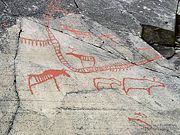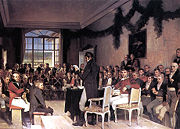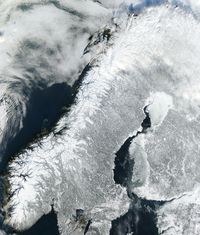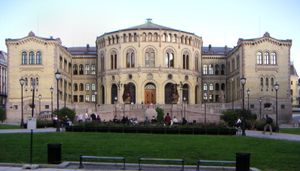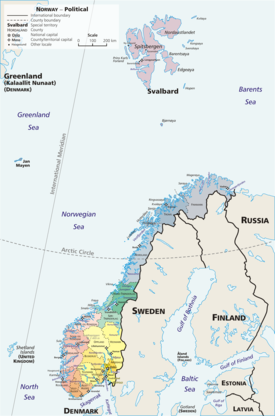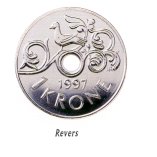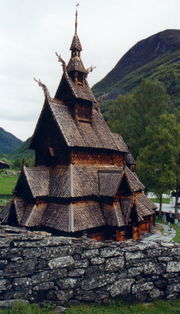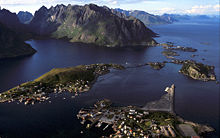Norway
2008/9 Schools Wikipedia Selection. Related subjects: Europe; European Countries
| Kongeriket Norge Kongeriket Noreg Kingdom of Norway
|
||||||
|---|---|---|---|---|---|---|
|
||||||
| Motto: Royal: Alt for Norge / Alt for Noreg
(All for Norway) 1814 Eidsvoll oath: Enig og tro til Dovre faller (United and loyal until the mountains of Dovre crumble) |
||||||
| Anthem: Ja, vi elsker dette landet Royal anthem: Kongesangen |
||||||
|
Location of Norway (orange)
on the European continent (white) |
||||||
| Capital (and largest city) |
Oslo |
|||||
| Official languages | Norwegian ( Bokmål and Nynorsk)1 | |||||
| Demonym | Norwegian | |||||
| Government | Parliamentary democracy and Constitutional monarchy | |||||
| - | Monarch | Harald V | ||||
| - | Prime Minister | Jens Stoltenberg ( Ap) | ||||
| Establishment | ||||||
| - | Unification | 872 | ||||
| - | Constitution | 17 May, 1814 | ||||
| - | Independence from union with Sweden |
declared 7 June, 1905 |
||||
| Area | ||||||
| - | Total | 385,252 km² ( 61st2) 148,746 sq mi |
||||
| - | Water (%) | 7.0 | ||||
| Population | ||||||
| - | 2008 estimate | 4,752,735 ( 114th) | ||||
| - | Density | 12/km² ( 202nd) 31/sq mi |
||||
| GDP ( PPP) | 2007 estimate | |||||
| - | Total | $257.4 billion ( 40th) | ||||
| - | Per capita | $55,600 ( 3rd) | ||||
| GDP (nominal) | 2007 estimate | |||||
| - | Total | $391.3 billion ( 25th) | ||||
| - | Per capita | $83.922 (486.335 NOK) ( 2nd) | ||||
| Gini (2000) | 25.8 (low) ( 6th) | |||||
| HDI (2007) | ▲ 0.968 (high) ( 2nd) | |||||
| Currency | Norwegian krone ( NOK) |
|||||
| Time zone | CET ( UTC+1) | |||||
| - | Summer ( DST) | CEST ( UTC+2) | ||||
| Internet TLD | .no5 .sj and .bv | |||||
| Calling code | +47 | |||||
| 1 | Northern Sami is used in the municipal administration of six municipalities, Lule Sami in one, and Finnish/ Kven in one. | |||||
| 2 | Includes Svalbard and Jan Mayen. | |||||
| 3 | This percentage is for the mainland and also includes glaciers | |||||
| 4 | Statistics Norway estimation ( September 5, 2006) using variant MMMM from Table 10 | |||||
| 5 | Two more TLDs have been assigned, but to date not used: .sj for Svalbard and Jan Mayen; .bv for Bouvet Island. | |||||
Norway ( Norwegian: Norge ( bokmål) or Noreg ( nynorsk)), officially the Kingdom of Norway, is a constitutional monarchy in Northern Europe that occupies the western portion of the Scandinavian Peninsula. It is bordered by Sweden, Finland, and Russia, while the United Kingdom and the Faroe Islands lie to its west across the North Sea. The country's extensive coastline along the North Atlantic Ocean is home to its famous fjords.
Norway also includes the Arctic island territories of Svalbard and Jan Mayen. Norwegian sovereignty over Svalbard is based upon the Svalbard Treaty, but that treaty does not apply to Jan Mayen. Bouvet Island in the South Atlantic Ocean and Peter I Island and Queen Maud Land in Antarctica are external dependencies, but those three entities do not form part of the kingdom.
Since World War II, Norway has experienced rapid economic growth, and is now amongst the wealthiest countries in the world. Norway is the world's third largest oil exporter after Russia and Saudi Arabia and the petroleum industry accounts for around a quarter of GDP. It has also rich resources of gas fields, hydropower, fish, forests, and minerals. Norway was the second largest exporter of seafood (in value, after China) in 2006. Other main industries include food processing, shipbuilding, metals, chemicals, mining, fishing and pulp and paper products. Norway has a Scandinavian welfare system and the largest capital reserve per capita of any nation.
Norway was ranked highest of all countries in human development from 2001 to 2006, and came second in 2007 (to fellow Nordic country Iceland). It also rated the most peaceful country in the world in a 2007 survey by Global Peace Index. It is a founding member of NATO.
Name
Norway is officially called Kongeriket Norge in the bokmål written norm, and Kongeriket Noreg in the nynorsk written norm. In other languages spoken in Norway the country is known as
- Northern Sami: Norga, or Norgga gonagasriika
- Lule Sami: Vuodna or Vuona gånågisrijkka
- Southern Sami: Nøørje or Nøørjen gånkarijhke
- Finnish/ Kven: Norja or Norjan kuningaskunta
Many etymologists believe the country's name comes from the North Germanic languages and that it means "the northern route" (the way to the north), which in Old Norse would be nord veg or *norð vegri. The Old Norse name for Norway was Nóreegr, in Anglo-Saxon Norþ weg, and in Medieval Latin Nhorvegia.
The Old Norse and nynorsk forms are quite similar to an ancient Sami word that means "along the coast" or "along the sea" — realized as nuorrek in contemporary Lule Sami. The presence of the archaic prosecutive case marker (sometimes also called prolative in Finno-Ugric language research) supports the claim that the Sami word is indigenous and not a borrowing from North Germanic languages.
The earliest known written occurrence of the name "Norway" is in the late 9th century, Old English translation of Orosius' Seven Books of History Against The Pagans, written by King Alfred the Great of Wessex, and adapted by him to include an account of the travels of Ohthere of Hålogaland.
History
Archaeological findings indicate that Norway was inhabited at least since early 10th millennium BC. Most historians agree that the core of the populations colonizing Scandinavia came from the present-day Germany. In the first centuries AD, Norway consisted of a number of petty kingdoms. According to tradition, Harald Fairhair unified them into one, in 872 AD after the Battle of Hafrsfjord, thus becoming the first king of a united Norway.
The Viking age, 8-11th centuries AD, was characterized by expansion and immigration. Many Norwegians left the country to live in Iceland, the Faroe Islands, Greenland and parts of Britain and Ireland. The modern-day Irish cities of Limerick, Dublin, and Waterford were founded by Norwegian settlers. Norse traditions were slowly replaced by Christianity in the 9th and 10th centuries, and this is largely attributed to the missionary kings Olav Tryggvasson and St. Olav. Haakon the Good was Norway's first Christian king, in the mid tenth century, though his attempt to introduce the religion was rejected.
In 1349, the Black Death killed between 40% and 50% of the population, resulting in a period of decline, both socially and economically. Ostensibly, royal politics at the time resulted in several personal unions between the Nordic countries, eventually bringing the thrones of Norway, Denmark, and Sweden under the control of Queen Margrethe I of Denmark when the country entered into the Kalmar Union. Although Sweden broke out of the union in 1523, Norway remained till 1814, a total of 434 years. The National romanticism of the 19th century, the centralization of the kingdom's royal, intellectual, and administrative powers in Copenhagen, Denmark, the dissolution of the archbishopric in Trondheim with the introduction of Protestantism in 1537, as well as the distribution of the church's incomes to the court in Copenhagen meant that Norway lost the steady stream of pilgrims to the relics of St. Olav at the Nidaros shrine, and with them, much of the contact with cultural and economic life in the rest of Europe. The steady decline was highlighted by the loss of the provinces Båhuslen, Jemtland, and Herjedalen to Sweden, as a result of wars.
After Denmark–Norway was attacked by Great Britain, it entered into an alliance with Napoleon, with the war leading to dire conditions and mass starvation in 1812. As the kingdom found itself on the losing side in 1814 it was forced to cede Norway to the kingdom of Sweden, while the old Norwegian provinces of Iceland, Greenland and the Faroe Islands remained with the Danish crown. Norway took this opportunity to declare independence, adopted a constitution based on American and French models, and elected the Danish crown prince Christian Fredrik as king on May 17, 1814. This caused the Norwegian-Swedish War to break out between Sweden and Norway but as Sweden's military was not strong enough to defeat the Norwegian forces outright, Norway agreed to enter a personal union with Sweden. Under this arrangement, Norway kept its liberal constitution and independent institutions, except for the foreign service.
This period also saw the rise of the Norwegian romantic nationalism cultural movement, as Norwegians sought to define and express a distinct national character. The movement covered all branches of culture, including literature ( Henrik Wergeland, Bjørnstjerne Bjørnson, Peter Christen Asbjørnsen, Jørgen Moe, Henrik Ibsen), painting ( Hans Gude, Adolph Tidemand), music ( Edvard Grieg), and even language policy, where attempts to define a native written language for Norway led to today's two official written forms for Norwegian: Bokmål and Nynorsk.
Christian Michelsen, a Norwegian shipping magnate and statesman, Prime Minister of Norway from 1905 to 1907 played a central role in the peaceful separation of Norway from Sweden on June 7, 1905. After a national referendum confirmed the people's preference for a monarchy over a republic, the Norwegian government offered the throne of Norway to the Danish Prince Carl and Parliament unanimously elected him king. He took the name of Haakon VII, after the medieval kings of independent Norway. In 1898, all men were granted universal suffrage, followed by all women in 1913.
During both World wars Norway claimed neutrality but during World War II it was invaded by German forces on April 9, 1940 while the allies also had plans in mind for an invasion of the country. In April 1940, the British fleet mined Norwegian territorial waters. Norway was unprepared for the German surprise attack, but military resistance continued for two months. During the Norwegian Campaign, the Kriegsmarine lost many ships including the cruiser Blücher. The battles of Vinjesvingen and Hegra eventually became the last strongholds of Norwegian resistance in southern Norway in May, while the armed forces in the north launched an offensive against the German forces in the Battles of Narvik, until they were forced to surrender on June 10. On the day of the invasion, the collaborative leader of the small National-Socialist party Nasjonal Samling — Vidkun Quisling — tried to seize power, but was forced by the German occupiers to step aside. Real power was wielded by the leader of the German occupation authority, Reichskommissar Josef Terboven. Quisling, as minister president, later formed a collaborationist government under German control. At the time of the invasion, Norway had the fourth largest merchant marine in the world led by the shipping company Nortraship, which under the Allies took part in every war operation from the evacuation of Dunkirk to the Normandy landings.
Following the war, the Social Democrats came to power and ruled the country for much of the cold war. Norway joined NATO in 1949, and became a close ally of the United States. Two plebiscites to join the European Union failed by narrow margins in 1972 and 1994. Large reserves of petroleum and natural gas were discovered in the 1960s, which led to a continuing boom in the economy.
Geography, climate and environment
Norway comprises the western part of Scandinavia in Northern Europe. The rugged coastline, broken by huge fjords and thousands of islands, stretches over 2,500 km as the crow flies and over 83,000 km including the fjords and islands. Norway shares a 2,542 km land border with Sweden, Finland, and Russia to the east. To the west and south, Norway is bordered by the Norwegian Sea, the North Sea, and Skagerak. The Barents Sea washes on Norway's northern coasts.
At 385,252 km² (including Jan Mayen, Svalbard), Norway is slightly larger than Germany, but much of the country is dominated by mountainous or high terrain, with a great variety of natural features caused by prehistoric glaciers and varied topography. The most noticeable of these are the fjords: deep grooves cut into the land flooded by the sea following the end of the Ice Age. The longest is Sognefjorden. Norway also contains many glaciers and waterfalls.
The land is mostly made of hard granite and gneiss rock, but slate, sandstone and limestone are also common, and the lowest elevations have marine deposits. Due to the Gulf Stream and prevailing westerlies, Norway experiences warmer temperatures and more precipitation than expected at such northern latitudes, especially along the coast. The mainland experiences four distinct seasons, with colder winters and less precipitation inland. The northernmost part has a mostly maritime Subarctic climate, while Svalbard has an Arctic tundra climate.
Due to Norway's high latitude, there are large seasonal variations in daylight. From late May to late July, the sun never completely descends beneath the horizon in areas north of the Arctic Circle (hence Norway's description as the "Land of the Midnight Sun") and the rest of the country experiences up to 20 hours of daylight per day. Conversely, from late November to late January, the sun never rises above the horizon in the north, and daylight hours are very short in the rest of the country. Throughout Norway, one will find stunning and dramatic scenery and landscape. The west coast of southern Norway + the coast of North Norway are among the most impressive coastlines anywhere in the world.
The 2008 Environmental Performance Index put Norway in second place, after Switzerland, based on the environmental performance of the country's policies.
Politics
Norway is a constitutional monarchy with a parliamentary system of government.
The Norwegian monarchy Norwegian Royal Family is a branch of the princely family of Glücksburg, originally from Schleswig-Holstein in Germany. Since 1991 the king had been Harald V.
The Constitution of Norway was adopted in 1814. It grants important executive powers to the King, but these are effectively always exercised by the Norwegian Council of State (the cabinet) in the name of the King. The king does act as cermonial head of state and a symbol of national unity and retains some reserve powers, which were used in World War II during the German occupation, when Haakon VII said he would abdicate rather than appoint a collaborationist government led by Vidkun Quisling. The King also opens the Parliament every October, receives ambassadors to the Norwegian court, and acts as the symbolic supreme commander of the Norwegian Defence Force and the High Protector of the Church of Norway, the established church.
The Council of State consists of a Prime Minister (the head of government) and other ministers, formally appointed by the King. Parliamentarism has evolved since 1884 and entails that the cabinet must not have the parliament against it, and that the appointment by the King is a formality when there is a clear majority in Parliament for a party or a coalition of parties. After elections resulting in no clear majority to any party or coalition, the leader of the party most likely to be able to form a government is appointed Prime Minister by the King. Norway has often been ruled by minority governments.
The King has government meetings every Friday at the Royal Palace (Council of State), but the government decisions are decided in advance in government conferences headed by the Prime Minister every Tuesday and Thursday. In order to form a government, more than half the membership of the Council of State is required to belong to the Church of Norway. Currently, this means at least ten out of 19 members. After the negotiations of looser ties between the church and the state, it was decided that this requirement will be abolished in the near future.
The Norwegian parliament is the Storting (Stortinget). It current has 169 members (an increased from 165 effective in the September 2005 elections). The members are elected from the 19 counties for four-year terms according to a system of proportional representation. An additional 19 seats ("levelling seats") are allocated on a nationwide basis to make the representation in parliament correspond better with the popular vote. There is a 4 percent election threshold to gain levelling seats.
The Storting is a qualified unicameral body. After elections it elects a quarter of its membership to form the Lagting, a sort of upper house, with the remaining three quarters forming the Odelsting, a lower house. When voting the two chambers divide, and this division of chambers is also used on very rare occasions such as impeachment. The original idea in 1814 was probably to have the Lagting act as an actual upper house, and the senior and more experienced members of the Storting were placed here. Laws are in most cases proposed by the government through a Member of the Council of State, or in some cases by a member of the Odelsting in case of repeated disagreement in the joint Storting. In modern times the Lagting rarely disagrees, effectively rubber-stamping the Odelsting's decisions.
Impeachment cases are very rare and may be brought against Members of the Council of State, of the Supreme Court (Høyesterett), or of the Storting for criminal offenses which they may have committed in their official capacity. The last case was in 1927, when Prime Minister Abraham Berge was acquitted.
Constitutional amendments of February 20, 2007 provide for:
- The abolition of division after the 2009 general election (making the Storting fully unicameral). Legislation will go through two readings, or three in case of dissent, before being passed and sent to the King for assent.
- Changes in impeachment procedures. The current system ( indictments raised by the Odelsting and judged by the Lagting and the Supreme Court justices as part of the High Court of the Realm) will be replaced by new system (indictments raised by the Storting in plenary session; impeachment cases will be heard by the five highest-ranking Supreme Court justices and six lay members in one of the Supreme Court courtrooms, instead of the Lagting chamber; Storting representatives no longer perform as lay judges).
The judiciary is referred to as the Courts of Justice of Norway. It consists of a Supreme Court of 18 permanent judges and a chief justice, appellate courts, city and district courts, and conciliation councils. Judges attached to regular courts are appointed by the king-in-council.
Each December Norway gives a Christmas tree to the United Kingdom in thanks for the UK's assistance during World War II. A ceremony takes place to erect the tree in Trafalgar Square.
In its 2007 Worldwide Press Freedom Index, Reporters Without Borders ranked Norway at a shared 1st place (with Iceland) out of 169 countries.
Corporal punishment of children has been illegal in Norway since 1983.
Foreign relations
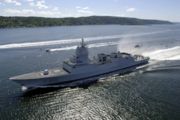
Norway maintains embassies in 86 countries around the world. Norway has diplomatic relations with many countries without maintaining an embassy in the country. 60 countries maintain an embassy in Norway, all of them in the capital, Oslo.
Norway was a founding member of the United Nations, NATO, the Council of Europe, the European Free Trade Association, the OECD and the OSCE, and maintains membership in several other international organisations. Norway has twice rejected proposed membership of the European Union although Norway has access to the European single market through membership in the European Economic Area.
Norway has also assisted in international negotiations, such as in facilitating the Oslo Accords.
Cities and municipalities
Norway is divided into nineteen first-level administrative regions known as fylker (" counties", singular fylke) and 430 second-level kommuner (" municipalities", singular kommune). The fylke is the intermediate administration between state and municipality. The King is represented in every county by a Fylkesmann.
There is ongoing debate as to whether the nineteen "fylker" should be replaced with five to nine larger regions. Some expect this to happen by 2010, whereas others expect the intermediate administration to disappear entirely. Another option would probably require consolidating the municipalities into larger entities and delegating greater responsibility to them.
The counties of Norway are:
- Akershus
- Aust-Agder
- Buskerud
- Finnmark
- Hedmark
- Hordaland
- Møre og Romsdal
- Nordland
- Nord-Trøndelag
- Oppland
- Oslo
- Østfold
- Rogaland
- Sogn og Fjordane
- Sør-Trøndelag
- Telemark
- Troms
- Vest-Agder
- Vestfold
Economy
Norwegians enjoy the second highest GDP per-capita (after Luxembourg) and third highest GDP (PPP) per-capita in the world, and has maintained first place in the world in the UNDP Human Development Index (HDI) for six consecutive years (2001-2006). However, in 2007 Iceland very narrowly beat Norway as the #1 place according to the Human Development Index.
The Norwegian economy is an example of mixed economy, featuring a combination of free market activity and large government ownership. The government controls key areas, such as the strategic petroleum sector ( StatoilHydro), hydroelectric energy production ( Statkraft), aluminium production ( Norsk Hydro), the largest Norwegian bank ( DnB NOR) and telecommunication provider ( Telenor). The government controls 31.6% of publicly listed companies. When non-listed companies are included the state has even higher share in ownership (mainly from direct oil license ownership).
Referendums in 1972 and 1994 indicated that the Norwegian people wished to remain outside the European Union (EU). However, Norway, together with Iceland and Liechtenstein, participates in the European Union's single market via the European Economic Area (EEA) agreement. The EEA Treaty between the European Union countries and the EFTA countries – transposed into Norwegian law via "EØS-loven" – describes the procedures for implementing European Union rules in Norway and the other EFTA countries. This makes Norway a highly integrated member of most sectors of the EU internal market. However, some sectors, such as agriculture, oil and fish, are not wholly covered by the EEA Treaty. Norway has also acceded to the Schengen Agreement and several other intergovernmental agreements between the EU member states.
The country is richly endowed with natural resources including petroleum, hydropower, fish, forests, and minerals. Norway has obtained one of the highest standards of living in the world in part by having a large amount of natural resources compared to the size of the population. The income from natural resources include a significant contribution from petroleum production and the substantial and well-managed income related to this sector. Norway also has a very low unemployment rate, currently below 2% (June 2007). The hourly productivity levels, as well as average hourly wages in Norway are among the highest in the world. The egalitarian values of the Norwegian society ensure that the wage difference between the lowest paid worker and the CEO of most companies is much smaller than in comparable western economies. This is also evident in Norway's low Gini coefficient.
Cost of living is about 30% higher in Norway than in the United States and 25% higher than the United Kingdom. The standard of living in Norway is high, and the continuing increase in oil prices ensure that Norway will remain one of the richest countries in the world over the foreseeable future.
Education
Higher education in Norway is offered by a range of seven universities, five specialised colleges, 25 university colleges as well as a range of private colleges. Education follows the Bologna process involving Bachelor (3 years), Master (2 years) and Doctor (4 years) degrees. Acceptance is offered after finishing upper secondary school with general study competence.
Public education is free, with an academic year with two semesters, from August to December and from January to June. The ultimate responsibility for the education lies with the Norwegian Ministry of Education and Research.
Demography
As of 2007, Norway's population numbered 4.7 million. Most Norwegians are ethnic Norwegians, a North Germanic people. The Sami people traditionally inhabit central and northern parts of Norway and Sweden, as well as in northern Finland and in Russia on the Kola Peninsula. Another national minority are the Kven people who are the descended of Finnish speaking people that moved to northern Norway in the 18th up to 20th century. Both the Sami and the Kven were subjected to a strong assimilation policy by the Norwegian government from the 19th century up to the 1970s. Because of this "Norwegianisation process", many families of Sami or Kven ancestry now self-identify as ethnic Norwegian . This, combined with a long history of co-habitation of the Sami and North Germanic peoples on the Scandinavian peninsula, makes claims about ethnic population statistics less straightforward than is often suggested — particularly in central and northern Norway. Other groups recognized as national minorities of Norway are Jews, Forest Finns, Roma/Gypsies and Romani people/Travellers.
In recent years, immigration has accounted for more than half of Norway's population growth. According to Statistics Norway (SSB), record 61,200 immigrants arrived in the country in 2007 — 35% higher than 2006. At the beginning of 2008, there were 459,600 persons in Norway with an immigrant background (i.e. immigrants, or born of immigrant parents), comprising 9.7% of the total population. 350,000 of these were from a non-Western background, which includes the formerly Communist countries according to the definition used by Statistics Norway. The largest immigrant groups by country of origin, in order of size, are Poles, Pakistanis, Swedish, Iraqis, Somalis , Vietnamese, Danes, and Germans.The Iraqi immigrant population has shown a large increase in recent years. After the enlargement of the EU in 2004, there has also been an influx of immigrants from Central and Eastern Europe, particularly Poland. The largest increase in 2007 was of immigrants from Poland, Germany, Sweden and Lithuania .
Religion
In common with other Scandinavian countries, the Norse followed a form of native Germanic paganism known as Norse paganism. By the end of the eleventh century, when Norway had been Christianized, the indigenous Norse religion and practices were prohibited. Anti- heathenry laws, however, were removed early in the twentieth century. Many remnants of the native religion and beliefs of Norway exist today, including names, referential names of cities and locations, the days of the week, and other parts of the everyday language.
Parts of the Sami minority retained their shamanistic religion well into the 18th century when they were converted to Christianity by Dano-Norwegian missionaries.
Nearly 83% of Norwegians are members of the state Church of Norway, to which they are registered at birth. Many remain in the state church to be able to use services such as baptism, confirmation, marriage and burial, rites which have strong cultural standing in Norway. Up to 40% of the membership attends church or religious meetings during a year, with fewer attending regularly.
According to the most recent Eurobarometer Poll 2005, 32% of Norwegian citizens responded that "they believe there is a god," whereas 47% answered that "they believe there is some sort of spirit or life force" and 17% that "they do not believe there is any sort of spirit, god, or life force."
Other Christian denominations total about 4.5% of the population. These include the Evangelical Lutheran Free Church, the Roman Catholic Church, Pentecostal congregations, the Methodist Church, Adventists, the Church of Jesus Christ of Latter-day Saints, and Jehovah's Witnesses and others. Among non-Christian religions, Islam is the largest, representing about 1.5% of the population: It is practiced mainly by the Somalian, Arab, Albanian, Pakistani and Turkish communities. Other religions comprise less than 1% each, including Judaism (see Jews in Norway). Indian immigrants introduced Hinduism to Norway, but account for fewer than 5,000 people, or 1% of non-Lutheran Norwegians. There are eleven Buddhist organizations, grouped under the Buddhistforbundet organisation, which make up 0.42% of the population. Around 1.5% of Norwegians adhere to the secular Norwegian Humanist Association. About 5% of the population is unaffiliated.
Languages
The North Germanic Norwegian language has two official written forms, Bokmål and Nynorsk. They have officially equal status, i.e. they are both used in public administration, in schools, churches, radio and television, but Bokmål is used by the vast majority, about 85-90%. Around 95% of the population speak Norwegian as their native tongue, although many speak dialects that may differ significantly from the written language. In general Norwegian dialects are inter-intelligible, though some may require significant effort. Several Finno-Ugric Sami languages are spoken and written throughout the country, especially in the north, by the Sami people. The state recognises these languages as official, and speakers have a right to get education in Sami language no matter where they are living, and receive communications from government in various Sami languages. The Kven minority speak the Finno-Ugric Kven language/Finnish.
Norwegian is highly similar to the other languages in Scandinavia, Swedish and Danish. All three languages are mutually intelligible and can be, and commonly are, employed in communication between inhabitants of the Scandinavian countries. As a result of the cooperation within the Nordic Council, inhabitants of all Nordic countries, including Iceland and Finland, have the right to communicate with the Norwegian authorities in their own language.
Any Norwegian student who is a child of immigrant parents is encouraged to learn the Norwegian language. The Norwegian government offers language instructional courses for immigrants wishing to obtain Norwegian citizenship.
The main foreign languages taught in Norwegian elementary school are English, German and French. Spanish, Russian, Japanese and Italian are available in some schools, mostly in the cities.
Literature
The history of Norwegian literature starts with the pagan Eddaic poems and skaldic verse of the 9th and 10th centuries with poets such as Bragi Boddason and Eyvindr Skáldaspillir. The arrival of Christianity around the year 1000 brought Norway into contact with European medieval learning, hagiography and history writing. Merged with native oral tradition and Icelandic influence this was to flower into an active period of literature production in the late 12th and early 13th centuries. Major works of that period include Historia Norwegie, Thidreks saga and Konungs skuggsjá.
Little Norwegian literature came out of the period of the Scandinavian Union and the subsequent Dano-Norwegian union (1387—1814), with some notable exceptions such as Petter Dass and Ludvig Holberg. In his play Peer Gynt, Ibsen characterized this period as "Twice two hundred years of darkness/brooded o'er the race of monkeys", although the latter line is not as frequently quoted as the former. During the union with Denmark, written Norwegian was replaced by Danish.
Two major events precipitated a major resurgence in Norwegian literature. In 1811 a Norwegian university was established in Christiania Seized by the spirit of revolution following the American and French Revolutions, the Norwegians signed their first constitution in 1814. Soon, the cultural backwater that was Norway brought forth a series of strong authors recognized first in Scandinavia, and then worldwide; among them were Henrik Wergeland, Peter Asbjørnsen, Jørgen Moe and Camilla Collett.
By the late 19th century, in the Golden Age of Norwegian literature, the so-called Great Four emerged: Henrik Ibsen, Bjørnstjerne Bjørnson, Alexander Kielland, and Jonas Lie. Bjørnson's "peasant novels", such as "En glad gutt" (A Happy Boy) and "Synnøve Solbakken" are typical of the national romanticism of their day, whereas Kielland's novels and short stories are mostly realistic. Although an important contributor to early Norwegian romanticism (especially the ironic Peer Gynt), Henrik Ibsen's fame rests primarily on his pioneering realistic dramas such The Wild Duck and A Doll's House, many of which caused moral uproar because of their candid portrayals of the middle classes.
In the twentieth century three Norwegian novelists were awarded the Nobel prize in literature: Bjørnstjerne Bjørnson in 1903, Knut Hamsun for the book " Markens grøde" ("Growth of the Soil") in 1920, and Sigrid Undset in 1928. In the 20th century writers like Dag Solstad, Jostein Gaarder, Erik Fosnes Hansen, Jens Bjørneboe, Kjartan Fløgstad, Lars Saabye Christensen, Johan Borgen, Herbjørg Wassmo, Jan Erik Vold, Rolf Jacobsen, Olaf Bull, Jan Kjærstad, Georg Johannesen, Tarjei Vesaas, Sigurd Hoel, Arnulf Øverland and Johan Falkberget have made important contributions to Norwegian literature.



